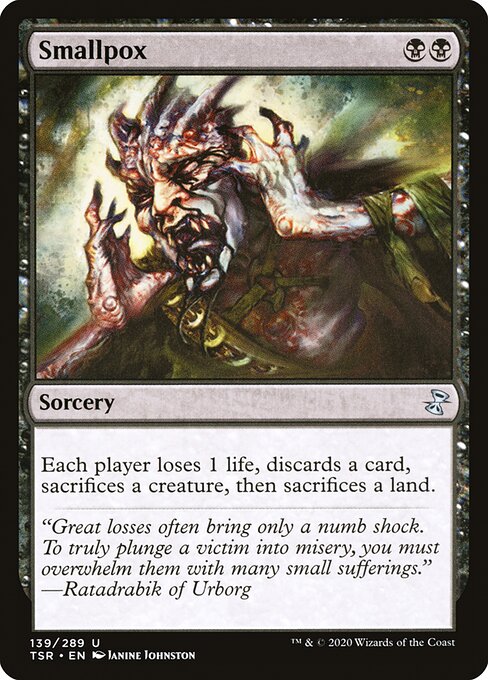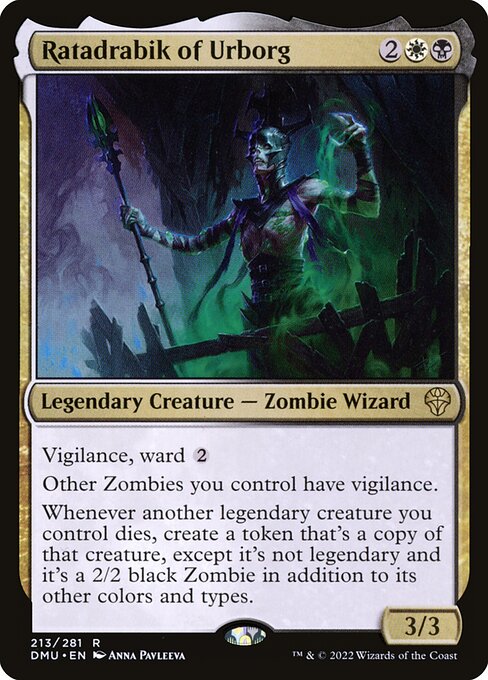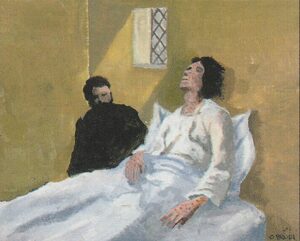I’m a Smallpox player. We are not loved by many. We share an affinity with Rack players (of which I am also). We crossover and commiserate. We like to control the game, deny resources, and generally cause chaos. We play a few cards that don’t often see tons of play in Modern. Whenever I cast Smallpox on turn 2 or put The Rack down on the battlefield with (or without) a spent Urza’s Saga, my opponent often has to read both cards. As if for the first time, often.
Them: “Okay. Lemme read this. What do I do? One life…okay. Sac a land? Sheesh. You do it, too?!”
Me: *nodding*

But the point is just that. I’m denying all resources. On purpose. To slow it aaalll down. Grind the game to a halt, or try to. When I started Modern, I kept hearing that it was a four turn format. I didn’t pay much attention to the claim. Well, that was foolish. My interest in playing Magic: The Gathering is to have a thorough and decently-paced game. Longer than four turns, for sure. That’s why I enjoy cards like Smallpox. I want value for my money and my time. If played in the first two to three turns, with the right board state, the card automatically adds (I’d wager) about four extra turns. There is a deliciously dark feeling in casting Smallpox on turn 2 with a Flagstones of Trokair tapping into a Fetid Heath for double black. Especially if my opponent has a one-drop creature out and a non-fetchland. While the punishment is symmetrical, if I’m not playing many creatures, or those without with recursion, then I’m likely up on the trade.
However, playing Smallpox in a mono-black deck, without any way to get back the land (other than playing 24 of them), is a true symmetrical infection.
A brutal form of parity.
The Strange Symbolism of Smallpox
Smallpox was first printed in Time Spiral. It’s only been around for 16 years. Half the lifetime of the game. Like I mentioned, the symmetry of the card’s effect is a boon to me–however, not many (if any other?) cards in Magic actually refer to a real world disease/element. This opens a different perspective on the card, symbolically. What do I mean by this? Well, it’s not as if we have a 0/1 {G} Rhinovirus card that reads:
When Rhinovirus enters the battlefield it sniffles. (Put a congestion counter on a land you own. When that land has three or more congestion counters on it, you may play a card called Sinusitis of the Nasal Caves.)
I’m being silly, of course. But my point stands: very little in the game of Magic is as isomorphic to our actual earthly reality as Smallpox is. I mean, imagine casting a card called “Coronavirus” or “COVID-19.” It’s a bit much, in retrospect.
We can’t ignore the namesake of the card. Coming out of a worldwide pandemic, it sort of feels “too soonish” to play this card. Pox–the actual disease–is any form of a disease that creates pustules on the skin. Smallpox–the real one–had pustules that could leave permanent scars and was attended by brutal fevers. Variations on smallpox are on record as existing in ancient Egypt and China. Complications could include blindness, encephalitis, and growth malformations. But, modern science has eradicated the disease. We should be thankful this is where we are in human history. And while I appreciate the card’s mechnics/effects, I am irked by the art on both the Time Spiral Janine Johnston version and Ryan Pancoast Magic 2012 rendition. The pustules are graphic. It’s a grim reminder of what can really happen.

The original flavor text was a quote from Ratadrabik of Urborg, a lich wizard. “Great losses often only bring a numb shock. To truly plunge a victim into misery, you must overwhelm him with many small sufferings.” Which explains the card’s dedication to the steady chipping away of an opponent’s board state and life totals. Playing two Smallpoxes back to back (which I have done), should end a game. This is reflected in the last line of the other version of the card’s flavor text: “Take away everything, and the oppression will be accepted as fate.” There’s a single callback to Smallpox as a card and it’s flavor.
On Dark Bargain from the Dominaria set, we see a mismatch of social castes. A human soldier in crimson cape and polished armor approaches a slum, where a trollish trader is holding up an potential offering. The flavor text is, we assume, this creature’s voice: “I have pustules of the great Ratadrabik, very cheap. No? Surely you’ll want a tincture of Nevinyrral’s pulverized remains. Genuine!” Could the soldier, whose face we can’t see, be one of the soldiers in the Smallpox depictions? Somehow, he’s survived and is looking for revenge? Who wouldn’t want revenge for having a creature and a land destroyed along with losing a card from one’s hand?
In a sense, Smallpox is a way to see how a player responds with reduced resources. Can they enact revenge? Can they come back? How are they at playing off-balance? I respect the constraints of the card’s effects. When I play Commander, the board states at a table often proliferate and mutate so fast that some players need to hire personal assistants to remember all the triggers that may fire. The same applies with certain Modern decks. Smallpox can, potentially, mitigate this if played at the exact right time. It can stop it from being merely a four turn format.

Pox by Cornelius Brudi
The Spreading of Pox in Magic
Before Smallpox was Pox. A {BBB} sorcery with a delicate oil painting of a dying patient in the style of Cezanne. And so, the first version of this effect is the bigger one. The original Pox (released in summer of 1995 with Ice Age) reads:
Each player loses a third of their life, then discards a third of the cards in their hand, then sacrifices a third of the creatures they control, then sacrifices a third of the lands they control. Round up each time.
Man, oh man. To think that Smallpox is a hurtful card? Obviously, we’re too far away from the OG Pox. I’ve read and heard jokes that there’s been Smallpox, regular Pox…so where’s Bigpox? I can’t imagine a card more devastating for both sides of the table than Pox. At least with Smallpox, there was room for shenanigans to get land back or to play around losing creatures. But Pox is just… devastation. It truly is what the physicist and author of On Thermonuclear War Herman Kahn described as “mutually assured destruction.” Which means when someone plays this card, what in the hell are they looking for from a game?
It may not surprise you (or it will anger you) to learn I was the kid who would flip the Monopoly board halfway through the game. It would be because one person had amassed an incredible lead, or it had gotten to where no one could advance. Magic gives players tools to correct this, just as nature had the tools.
To make an analogy: when the card Smallpox comes down on turn 2/turn 3 and an opponent groks the effects–and they have no counterspells–the look on their face is a ludic equivalent of such devastation. To sacrifice so much so early is a chaotic effect. However, let’s also be realistic: while I enjoy the mechanics, I sometimes wonder how much harder the card will have to work to get value nowadays. True, it can be run with Dakmor Salvage (which helps with Raven’s Crime) in a mono-black build or it can be run with a Flagstones of Trokair package for Orzhov. You can run it in a Golgari-type build and get lands back with Life from the Loam.
Many other columnists before me here have self-reflected on whether or not Magic has reached an exhaustion point for them. Last night, at Modern, I mused out loud that I might be done with the format. I was tired of getting outpaced for not playing a deck consisting of 75% Modern Horizons 2 cards. I was bummed by the light speed pace at which the games operated. A friend looked at me and said, “C’mon. You’re the Grim Reaper. You tear people’s hands apart.” In the next match, I played Burn. I played Smallpox around turn 5. It helped nail down a win, maybe the whole match. Is it possible that the one card that symbolizes all of my frustration with the format (even the whole game?) is the one card that could keep me playing it week after week?
In my first Swamp Talk column, I asked a silly question that may actually have a sad kernel of truth in it: Do I play mono black control because I’m broken or am I broken because I play mono black control? I don’t have an answer to this yet. But I do know that when I play Smallpox, I am fully conscious of the damage I’m doing to myself. I am, I like to think, creating a bulwark against many small sufferings.
Kyle Winkler (he/him) is a teacher and fiction writer. While he was pre-teen when Magic: The Gathering was released, he didn’t start playing until recently. He’s the author of the cosmic horror novella (The Nothing That Is), a collection of short stories (OH PAIN), and a novel (Boris Says the Words). He’s trying to make Obzedat, Ghost Council work as the commander for his most recent deck.

